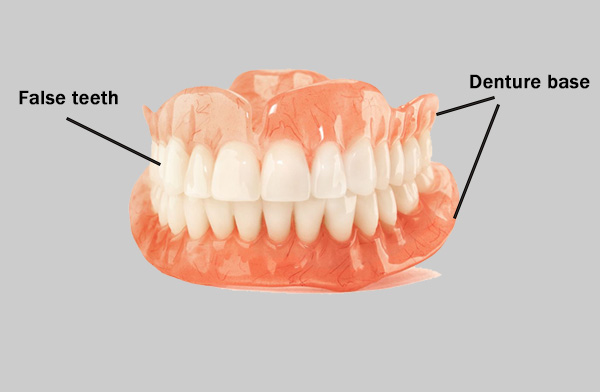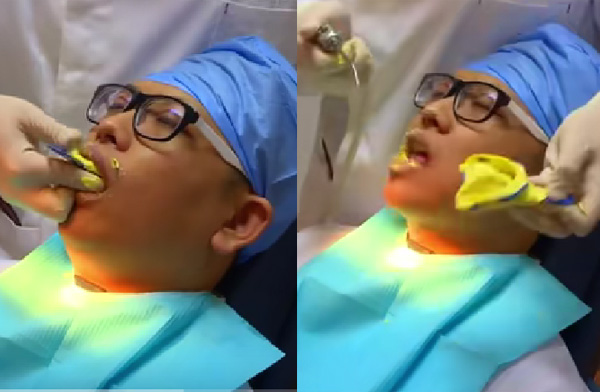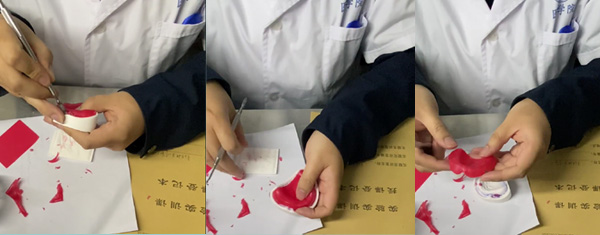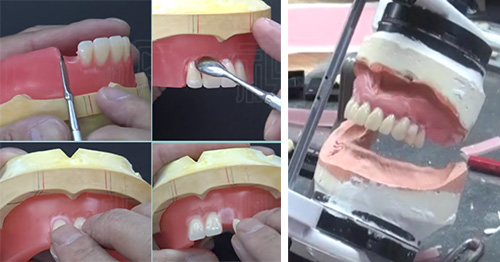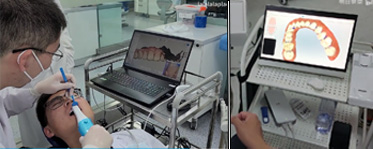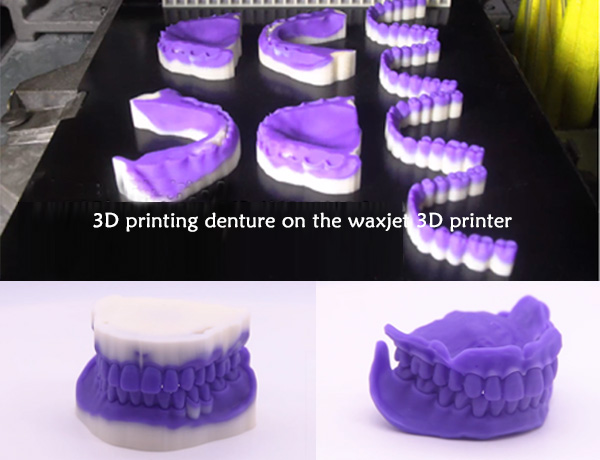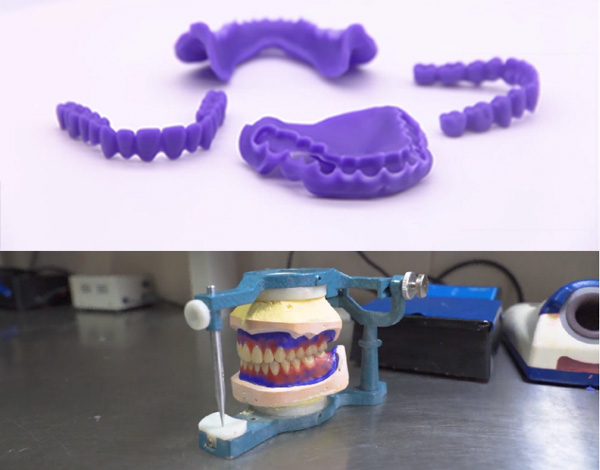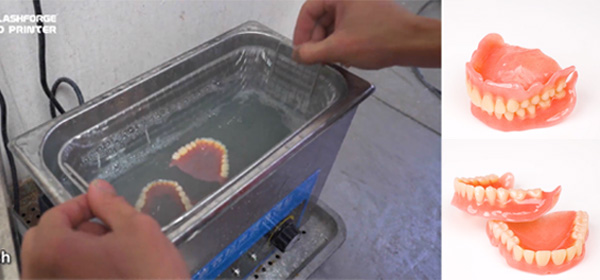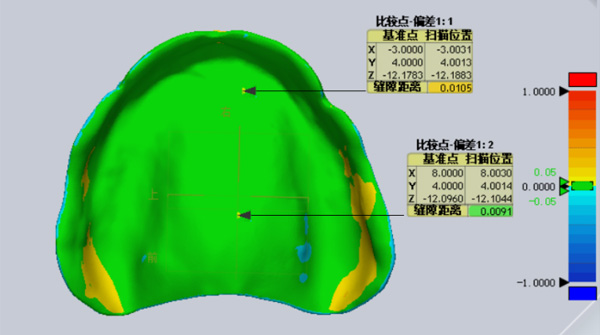This article illustrated how 3Dprinting is used in dentistry from a micro level. By specifically elaborating how a dental 3D printer helps in making final denture products, this article makes people who are interested/engaged in dental manufacturing know of 3D printer's utility in dentistry. No doubt that with the swiping of 3D printing technology, the dental manufacturing industry will be undergoing a transformation from traditional manual methods to digital fabrication!
The Importance of Precisely-Fabricated Wax Denture Modules
When manufacturing denture (commonly people say “false teeth”), the initial step of obtaining a precisely-fabricated wax denture module is crucial. This module serves as the foundation for the following procedures of wax lost casting and achieving the final denture that fits securely in the patient’s mouth.
Fabricating a wax denture module that is precisely fit for the patient is such an important factor that straightly affects whether the final denture would be well sucked on and not easily fall off the patient’s jaws, whether the final denture allows good bite between patient’s upper and lower jaws, or whether the patients could naturally close their mouth after wearing the denture.
▲Wax denture module(left); Final denture product(right)
3D printing in dentistry. 3D printer steps here for fabricating wax denture module by incorporating 3D printing technology into the fabrication process. Through the following comparison, let’s see how 3D printing way takes advantages over traditional way in fabricating wax denture module.
Traditional way of fabricating wax denture modules
Before going forewords, let’s get that a denture is composed of two parts: denture base and false teeth.
▲Denture: Denture base + false teeth
Hence, The manufacturing of wax denture module include two parts: making the wax denture base and installing teeth.
1. Getting patient's jaw impression
Dentists take a thick liquid material to patient’s mouth to get his jaw/teeth impression.
2. Getting Gypsum Jaw Model
Gypsum is cast into the impression molds to create a gypsum jaw model. The left part of the image below shows teeth impression, while for patients, especially elder patients who’ve lost all original teeth, they have no teeth impression and there will be no teeth molded on the gypsum model (as showed in the right part of the image).
3. Manual Fabrication of Wax Denture Base
Given the above said gypsum model, Dental lab technicians need to make a complete denture. Firstly he fabricates the wax denture base. The following image shows how they are putting a heated wax sheet on the model and manually make the complete denture base.
The production of the wax denture base, as well as the arrangement of teeth, heavily relies on the skills of dental lab technicians. This process demands exceptional craftsmanship and a high level of expertise, which greatly influences the quality control and cost aspects. If any mistakes occur during the manual fabrication process and issues are identified during the trial fitting, they cannot be promptly resolved. Consequently, it results in lengthy rework cycles, ultimately affecting the patient's treatment experience in a significant way.
4. Manual Installation of False Teeth
Artificial teeth are selected and manually installed on the denture base. The wax denture module is then adjusted to achieve the final form.
▲Arranging teeth
3D printing way of fabricating the wax denture modules
The specific case of 3D printing in dentistry is using 3D printers to make wax dentures. By studying the case of using Flashforge WaxJet 3D printers to make dental dentures, this article tends to make readers understand how 3D printing can be used in dentistry from a micro perspective.
1. 3D scanning
Dentists use oral scanners to scan the patient’s mouth and obtain digital model of the patient's mouth.
2. Computer Software Editing
The denture base and teeth installation are digitally designed on computer software. There are many advantages of digital designing dentures when comparing it to the traditional manual fabrication process.
Enhanced Precision and Fit: Digital designing allows for precise customization of the denture base and teeth arrangement, resulting in a superior fit and improved comfort for the patient. The use of advanced software tools ensures accurate measurements and alignment, minimizing any potential discrepancies that may arise in the traditional manual process.
Iterative Design and Visualization: Digital designing enables iterative modifications and visualizations of the denture design before its actual production. Dentists and technicians can simulate different tooth arrangements and evaluate their aesthetic and functional aspects in a virtual environment. This iterative process allows for optimal customization and patient satisfaction, enhancing the overall treatment outcome.
3. 3D print and get the wax denture module
3D printing in dentistry makes it possible to get a digital denture model to be physically real.
▲3D printing denture on the waxjet 3D printer
The digital denture module is 3D printed using a waxjet 3D printer, which allows for the simultaneous printing of both the denture base and false teeth. As a result, there may be a slight difference in the false teeth between the 3D printed denture and the manually fabricated one. In the case of the 3D printed denture, both the denture base and false teeth are constructed from wax since the material fed into the wax 3D printer is wax. And, it is a straightforward process for makers to replace the wax false teeth with real false teeth. Since the teeth impression is shaped on the denture base, it’s easy to have each tooth take its right place.
▲Replace wax false teeth with real false teeth
4. Further Steps in the Fabrication Process
After replacing teeth on the 3D printed denture module, the subsequent steps get similar to the traditional fabrication process. These steps include embedding the module, performing heat treatment to lost the wax, investing it with liquid resin, and getting the final denture (with resin denture base).
▲Lost-wax investment
▲Final denture (base is of resin material)
The 3D printer eligible for wax denture production
The waxjet 3D printer mentioned above for the production of wax denture is Flashforge WaxJet 400. 3D printing in dentistry solicits such a 3D printer specifically designed for the high precision required in dental production industries.
It employs a technology that allows it to print intricate details with extremely high resolution and accuracy, making it ideal for 3D printing complex wax denture modules. Besides, The WaxJet 400 excels in working efficiency and speed. With 3 print heads equipped on, WaxJet 400 wax 3D printer triples in production and outpaces other wax 3D printers in its class without compromising the quality of the output. This speed can be beneficial in a dental lab setting where time efficiency is highly valued.
Advantages Of Applying Wax 3D Printers To Denture Production
The application of 3D printing technology in dentistry, particularly with waxjet 3D printers, offers several advantages in the fabrication of complete dentures.
High Precision and Fit
3D printed denture modules exhibit high accuracy and excellent fit to patient’s jaw and mouth. The precise fit of the denture base, as demonstrated on the image below of minimal gaps (less than 0.01 mm) and deviations (less than 0.05mm), ensures optimal comfort and performance for the patient. This improved fit enhances the overall treatment experience for dental patients.
Standardizing Workflow and Reducing Rework Costs
3D printing technology seamlessly integrates with existing materials and workflows in manufacturing wax denture, reducing the need for rework and minimizing processing costs. The standardized workflow of 3D printing denture will improve efficiency and productivity in dental manufacturing.
Reducing Dependency on Manual Expertise/manual labor
Traditional dental laboratories heavily rely on experienced technicians. Master-apprentice system decides that a younger technician can only get knowledge of fabricating wax denture from his master. Besides, there are less and less young people who’d like to engage in manual craftsmanship. The introduction of 3D printing technology helps mitigate this issue by reducing dependence on manual expertise and increasing operational efficiency, thereby benefiting dental manufacturing companies.
In conclusion
Afrer reading the whole article you must have a clear understanding on how a 3D printer is helpful in making dentures and how 3D printing technology takes advantages over traditional way of denture fabricating. The integration of 3D printing in dentistry marks a significant paradigm shift in the manufacturing of dentures. The precision and efficiency of digital fabrication through 3D printers like the Flashforge WaxJet 400 eliminate the traditional challenges associated with manual labor, standardize workflow, and greatly reduce rework costs. By incorporating high-resolution scanning, digital designing, and 3D printing into the workflow, dental labs can offer their patients dentures that are meticulously crafted to ensure superior fit and comfort. This not only enhances the overall patient experience but also revolutionizes the dental manufacturing industry, paving the way for more innovative applications of 3D printing technology. As the digital wave in dentistry continues to grow, 3D printing is poised to become an indispensable tool, shaping the future of dental treatment and manufacturing.
Guess you also interest in reading:
3D Printer Used In Personalized Medicine: Making Patient-Specific Implants
Jewelry 3D printer debuts on JCK Jewelry show 2023
How Investment Casting Benefits from 3D Printing Technology







